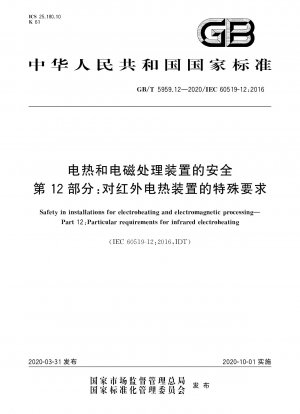GB/T 5959.12-2020
Safety in installations for electroheating and electromagnetic processing—Part 12: Particular requirements for infrared electroheating (English Version)
- Standard No.
- GB/T 5959.12-2020
- Language
- Chinese, Available in English version
- Release Date
- 2020
- Published By
- 国家市场监督管理总局、中国国家标准化管理委员会
- Latest
- GB/T 5959.12-2020
- Scope
- This article of GB/T5959.1-2019 is replaced by the following content. Replace: This part of GB/T5959 specifies the safety requirements for industrial electrothermal equipment and devices where the infrared radiation usually generated by an infrared emitter significantly exceeds thermal convection and heat conduction within the device as a heat transfer method to transfer energy to the materials being processed. A further limitation of the range is infrared emitters whose maximum spectral radiation wavelength is above 780 nm in air or vacuum and which emit a broad band continuous spectrum by e.g. thermal radiation or high-voltage arcs. GB/T5959.1-2019 defines infrared as optical radiation with a frequency range between approximately 400THz and 300GHz. The corresponding wavelength range in vacuum is 780nm~10μm. Industrial infrared heating usually uses infrared sources with rated temperatures between 500°C and 3000°C. The radiation emitted from these infrared sources is mainly in the wavelength range of 780nm to 10μm. Since a large number of thermal emitters may emit wavelengths below 780 nm or above 3000 nm, this section also considers safety aspects of visible light and radiation with wavelengths exceeding 3000 nm. This section does not apply to: ——Infrared devices using lasers or light-emitting diodes (LEDs) as the main radiation source --- GB/T20145-2006 and IEC60825-1:2014[2] are applicable to such devices; ——Public electrical appliances; ——Laboratory electrical appliances — IEC61010-1:2010 [3] is applicable to such appliances; ——Resistance heating bare wires, electric heating tubes or electric heating rods are used as heating elements, and infrared radiation is not Electric heating devices with dominant side effects in expected applications are specified by GB5959.4-2008[1]; ——Infrared heating equipment with a nominal total power of all infrared emitters less than 250W; ——Handheld infrared equipment. Industrial infrared electric heating equipment within the scope of this section usually utilizes the Joule effect to convert electrical energy into infrared radiation through one or more radiation sources, and then emits radiation from one or more elements to the material being processed. This is especially true for the following infrared heating elements: ——Tubular, plate or other-shaped ceramic thermal infrared emitters with resistive elements inside; ——Infrared quartz glass tubes or halogen lamp emitters using high-temperature filaments as radiation sources; ——Non-insulating components made of molybdenum disilicide, silicon carbide, graphite, iron-chromium-aluminum alloy, refractory metal or similar materials; ——Broad spectrum arc lamp.
GB/T 5959.12-2020 history
- 2020 GB/T 5959.12-2020 Safety in installations for electroheating and electromagnetic processing—Part 12: Particular requirements for infrared electroheating

GB/T 5959.12-2020 -All Parts
GB/T 5959.1-2019 Safety in installations for electroheating and electromagnetic processing—Part 1: General requirements
GB/T 5959.10-2015 Safety in electroheating installations.Part 10:Particular requirements for electrical resistance trace heating systems for industrial and commercial applications
GB/T 5959.11-2016 Safety in electroheat installations.Part 11:Particular requirements for installations using the effect of electromagnetic forces on liquid metals
GB/T 5959.12-2020 Safety in installations for electroheating and electromagnetic processing—Part 12: Particular requirements for infrared electroheating
GB/T 5959.41-2019 Safety in elcctroheating installations—Part 41: Particular requirements for resistance heating equipment—Heating and melting glass equipment